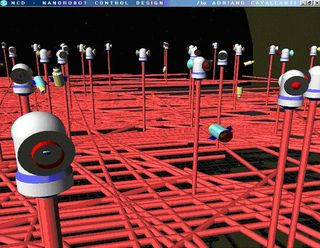December 5, 2007 feature
Virtual 3D nanorobots could lead to real cancer-fighting technology

From eliminating the side effects of chemotherapy to treating Alzheimer’s disease, the potential medical applications of nanorobots are vast and ambitious. In the past decade, researchers have made many improvements on the different systems required for developing practical nanorobots, such as sensors, energy supply, and data transmission.
But there is still a great deal of work to do before tiny “molecular machines” can begin traveling through our arteries for diagnosing or treating our ailments. To try to pick up the pace, a group of researchers has recently developed an innovative approach to help in the research and development of nanorobots – virtual reality.
Adriano Cavalcanti, Bijan Shirinzadeh, Robert Freitas, Jr., and Tad Hogg, representing institutions in Melbourne, Australia, and the U.S., have published their simulation procedure in a recent issue of Nanotechnology. Just as 3D simulations previously helped engineers greatly accelerate developmental research in the semiconductor industry, Cavalcanti and colleagues hope that virtual nanorobots, virtual biomolecules and virtual arteries will accelerate the progress of nanorobot development.
“The software NCD (nanorobot control design) is a system implemented to serve as a test bed for nanorobot 3D prototyping,” Cavalcanti, CEO of the Center for Automation in Nanobiotech and researcher at Monash University in Melbourne, told PhysOrg.com. “It is an advanced nanomechatronics simulator that provides physical and numerical information for nanorobot task-based modeling. Serving as a fast development platform for medical nanorobots investigation, the NCD simulations show how to interact and control a nanorobot inside the body.”
In a demonstration of the real-time simulation, the nanorobots had the task of searching for proteins in a dynamic virtual environment, and identifying and bringing those proteins to a specific “organ-inlet” for drug delivery. The researchers analyzed how the nanorobots used different strategies to achieve this goal. For instance, the nanorobots could employ different sensory capabilities such as chemical and temperature sensors, as well as random movement.
For the nanorobots, one of the most difficult parts was maneuvering close enough to a biomolecule to be able to sense that biomolecule, while accounting for many different forces and moving bodies. Unlike on the macroscale, viscosity dominates movement in arteries, affecting the nanorobots’ traveling as it encounters obstacles and proteins moving passively through the fluid.
To demonstrate the system, the researchers tested several cases where the nanorobots used different strategies to detect proteins, and in vessels with varying diameters. As expected, their results showed that nanorobots have a better chance of finding a target in smaller vessels. Also, the use of both chemical and thermal biosensors greatly improved the nanorobots’ efficiency compared with random motion.
In addition to sensing, the simulation will hopefully provide interactive tools for many challenging aspects of nanorobot design, such as control methods, manufacturing approaches, actuator (motor) design, and more. The researchers are currently using the simulation for tests in laparoscopic surgery, diabetes, cancer, brain aneurysms, cardiology, military biohazard defense, and drug delivery. The development is highly collaborative, with advances depending on future improvements in nanoelectronics, new materials, and genomics research.
“One of the major factors for successfully developing nanorobots is to bring together professionals with interdisciplinary views of science and technologies,” Cavalcanti said. “It is necessary to keep your eyes open for chemistry, materials engineering, electronics, computing, physics, mechanics, photonics, pharmaceutics, and medicine technologies. Our work is advancing progressively because we have experts from different backgrounds participating. We all pursue a common interest in working together to build medical nanorobots.”
With all these disciplines moving ahead, a precise simulation system can help researchers understand the performance requirements for practical nanorobots, even before the technologies exist.
“Some existing components, like sensors, motors, actuators and antennas, are already available as nanodevices,” said Cavalcanti. “Then you have to take the next step: those components should be integrated as embedded parts assembled into a nanorobot.”
He explained that the biggest motivator for innovation comes from economic and strategic interests. Due to the wide variety of applications, nanorobots will almost certainly offer economic incentives.
“In the case of nanorobots, you have huge potential for commercialization, with enormous chances of profit for the medical and pharmaceutical sectors,” Cavalcanti said. “Among other applications in medicine, nanororobots also represent an important strategic technology for military defense against biohazard contamination, which should help to protect against different sorts of pandemic outbreaks.”
Due to these motivations, Cavalcanti hopes that working nanorobots will be here in the not-too-distant future.
“If you consider the velocity that miniaturization is moving, from micro to nanoelectronics, then you can easily understand the feasibility to have medical nanorobots integrated as a nanoelectronic molecular machine before 2015,” he predicted, adding that nanorobots, like all medical technologies, would still need to undergo safety testing, which would push back the date for mass production and commercialization.
More information: www.nanorobotdesign.com
Publication: Cavalcanti, Adriano, Shirinzadeh, Bijan, Freitas, Robert A Jr., and Hogg, Tad. “Nanorobot architecture for medical target identification.” Nanotechnology 19 (2008) 015103 (15pp).
Copyright 2007 PhysOrg.com.
All rights reserved. This material may not be published, broadcast, rewritten or redistributed in whole or part without the express written permission of PhysOrg.com.




















